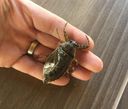Lethocerus
Lethocerus
Classification
- Phylum: Arthropoda
- Subphylum: Hexapoda
- Class: Insecta
- Order: Hemiptera
- Suborder: Heteroptera
- Infraorder: Nepomorpha
- Superfamily: Nepoidea
- Family: Belostomatidae
- Subfamily: Lethocerinae
- Genus: Lethocerus
Pronunciation
How to pronounce Lethocerus: /lɛˈθɒsərəs/
These audio files are automatically generated. While they are not always 100% accurate, they are a good starting point.
Images






Summary
Lethocerus is a genus of giant water bugs known for their significant size, predatory behavior, and occurrence in various water bodies globally. They are notable for their unique reproductive strategies and painful bites.
Physical Characteristics
Lethocerus species are among the largest true bugs, capable of reaching a length of over 12 centimeters (4.7 in). Most species typically range between 4.5 and 9 cm (1.8 and 3.5 in). They have two symmetrical furrows in the inner pad of setae on the fore femur and their external borders of parasternites II and III are narrowed and nearly straight.
Identification Tips
Distinguished from other genera in the subfamily Lethocerinae (Benacus and Kirkaldyia) by unique morphological features such as the two symmetrical furrows on the fore femur.
Habitat
Ponds and shallow margins of lakes containing submerged or emergent vegetation.
Distribution
Most species are found throughout North America, with total distribution in tropical, subtropical, and temperate areas of the world. Greatest diversity of species occurs in the Americas.
Diet
Predominantly carnivorous, feeding on any animal they can handle, including aquatic invertebrates, small fish, tadpoles, frogs, and small birds.
Life Cycle
The species undergoes a simple life cycle, comprising eggs, nymphs, and adults. Nymphs molt five times before becoming adults. They overwinter as adults found in the mud at the bottom of ponds or lake margins.
Reproduction
Females lay eggs near or in water on emergent vegetation, often in rows of brownish-gray eggs, with approximately 100 eggs in a group. Eggs hatch in about 2 weeks and are guarded by males.
Predators
Natural predators include birds, larger aquatic species, and other aquatic insects.
Ecosystem Role
Lethocerus species play a key role as predators in their aquatic ecosystems, helping to control populations of smaller aquatic organisms.
Economic Impact
Some species are consumed in Southeast Asia, and certain species may have economic significance for local fisheries.
Health Concerns
Bites from Lethocerus can be very painful, causing swelling and pulsating pain, although symptoms typically resolve within about five hours.
Evolution
The oldest known fossil of the genus is an indeterminate species from the Bembridge Marls, Isle of Wight, UK.
Similar Taxa
- Benacus
- Kirkaldyia
Misconceptions
Often referred to as "toe biters" due to their painful bite, leading to a fear of them despite their ecological benefits.
Tags
- giant water bug
- Hemiptera
- predator
- aquatic insects
- toebiter